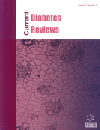- Home
- A-Z Publications
- Current Diabetes Reviews
- Previous Issues
- Volume 14, Issue 4, 2018
Current Diabetes Reviews - Volume 14, Issue 4, 2018
Volume 14, Issue 4, 2018
-
-
Socioeconomic Status: The Missing Link Between Obesity and Diabetes Mellitus?
More LessBackground: Currently, there is an epidemic expansion of obesity rates worldwide. The increasing number of obese individuals associated with the aging of population leads to increasing number of individuals with type 2 diabetes mellitus (T2DM) at the same rate. The traditional factors that link obesity to T2DM are related to genetics, hypercaloric diet, sedentary lifestyle, and stress. Individuals from lower Socioeconomic Status ( Read More
-
-
-
Dipeptidyl Peptidase-4 Inhibitor Induced Angioedema – An Overlooked Adverse Drug Reaction?
More LessIntroduction: Angioedema is a potentially fatal adverse drug reaction of some medications, as swellings of the upper airways can cause death by asphyxiation. Angiotensin converting enzymeinhibitors are widely known to cause angioedema but less is known about the association between dipeptidyl peptidase-4 inhibitors (gliptins) and angioedema. Dipeptidyl peptidase-4 inhibitors are antidiabetic drugs used to improve glyc Read More
-
-
-
The Possible Hypoglycemic Mechanisms of Echinochrome
More LessAuthors: Ayman S. Mohamed, Amel Mahmoud Soliman and Mohamed-Assem Said MarieBackground: Diabetes mellitus is the main reason of morbidity and mortality worldwide. In recent years great attention has been paid to bioactivity of natural products due to their potential pharmacological utilization. Echinochrome is a natural compound isolated from sea urchins and possesses many biological effects. The hypoglycemic activity of echinochrome reported in many recent experiments. Objective: In our study, we tri Read More
-
-
-
Is Fish Oil a Potential Treatment for Diabetic Peripheral Neuropathy?
More LessBackground: Peripheral neuropathy affects about 50% of the diabetic population. The manifestations range from pain, numbness, paresthesia and ulceration in the extremities and it is the major cause of non-traumatic amputations. Currently there is no effective treatment for peripheral neuropathy. With the prevalence of obesity and type 2 diabetes and associated complications reaching epidemic levels, there is a critical Read More
-
-
-
Aspartame: Should Individuals with Type II Diabetes be Taking it?
More LessBackground: Individuals with Type II Diabetes (T2D) have to manage blood glucose levels to sustain health and longevity. Artificial sweeteners (including aspartame) are suggested sugar alternatives for these individuals. The safety of aspartame in particular, has long been the centre of debate. Although it is such a controversial product, many clinicians recommend its use to T2D patients, during a controlled diet and as p Read More
-
-
-
An Evaluation of the Clinical Therapeutic Effect of Lixisenatide in Type 2 Diabetes Patients: A Systematic Literature Review
More LessAuthors: Arinze N. Okere, Janele Montesdeoca, April Glasper and Vakaramoko DiabyBackground: With cardiovascular disease accounting for approximately 50% of deaths in patients diagnosed with type 2 diabetes, it is pertinent to initiate anti-diabetic medications with cardiovascular benefits. This systematic clinical review critically examines the clinical therapeutic effect of lixisenatide. Methods: Data were gathered from articles indexed in PubMed, Google Scholar and Medline from 2010 - 2017, with the follo Read More
-
-
-
Patient Impressions of Possible Catastrophic Outcomes after Diabetic Foot Ulceration
More LessBackground: Diabetes Mellitus (DM) and its complications are well studied; patients with diabetes may suffer from neuropathy and vascular issues, and associated with these, lower extremity ulceration. Ulcers are often refractory to treatment, and can be difficult for both patients and clinicians to manage. Such complications may lead to amputations, which in turn are a risk factor for death. However, in certain situations amput Read More
-
-
-
Anti-islet Cell Antibodies in a Sample of Egyptian Females with Gestational Diabetes and its Relation to Development of Type 1 Diabetes Mellitus
More LessBackground: Gestational diabetes mellitus is any degree of glucose intolerance with first diagnosis during pregnancy; it affects 3-10% of pregnancies. The presence of diabetes-related autoantibodies has shown to be able to predict the development of type 1 diabetes before hyperglycemia arises. Objective: To recognize the prevalence of islet cell antibodies among a sample of Egyptian females with gestation Read More
-
-
-
Glycemic Variability and Insulin Needs in Patients with Type 1 Diabetes Mellitus Supplemented with Vitamin D: A Pilot Study Using Continuous Glucose Monitoring System
More LessAuthors: Karem M. Felício, Ana Carolina Contente Braga de Souza, Joao F. A. Neto, Franciane Trindade Cunha de Melo, Carolina Tavares Carvalho, Thais Pontes Arbage, Hana Andrade de Rider Brito, Amanda Soares Peixoto, Alana Ferreira de Oliveira, Fabricio de Souza Resende, Scarlatt Sousa Reis, Ana Regina Motta, Henrique da Costa Miranda, Luisa Correa Janau, Elizabeth Sumi Yamada and Joao Soares FelicioBackground: Recent studies suggest that glycemic variability could influence the risk of complications in Type 1 Diabetes Mellitus (T1DM). There are no data about the action of Vitamin D (VD) on glycemic variability. Our pilot study aims to evaluate glycemic variability and insulin needs in patients with T1DM supplemented with VD. Methods: 22 Patients received doses of 4000 and 10000 IU/day of cholecalciferol for 12 weeks, accor Read More
-
Volumes & issues
-
Volume 21 (2025)
-
Volume 20 (2024)
-
Volume 19 (2023)
-
Volume 18 (2022)
-
Volume 17 (2021)
-
Volume 16 (2020)
-
Volume 15 (2019)
-
Volume 14 (2018)
-
Volume 13 (2017)
-
Volume 12 (2016)
-
Volume 11 (2015)
-
Volume 10 (2014)
-
Volume 9 (2013)
-
Volume 8 (2012)
-
Volume 7 (2011)
-
Volume 6 (2010)
-
Volume 5 (2009)
-
Volume 4 (2008)
-
Volume 3 (2007)
-
Volume 2 (2006)
-
Volume 1 (2005)
Most Read This Month
Article
content/journals/cdr
Journal
10
5
false
en


